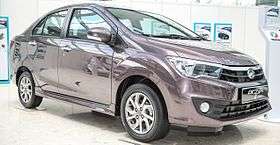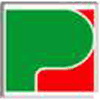Perodua
 The current Perodua logo since 2008 | |
|
| |
| Limited company | |
| Industry | Automotive |
| Founded | 1993 |
| Headquarters | Serendah, Selangor, Malaysia |
Key people | Datuk Aminar Rashid Salleh (President and CEO) |
| Products | Economy cars |
Number of employees | 10,000 |
| Parent |
UMW Corporation (38%) Daihatsu (25%) MBM Resources (20%), PNB Equity Resources (10%), Mitsu & Co. Ltd (7%) |
| Website |
www |
The Perusahaan Otomobil Kedua Sendirian Berhad (Second Automobile Manufacturer Private Limited), usually abbreviated to Perodua /pəˈrɒdjuːə/, is Malaysia's largest automobile manufacturer closely followed by Proton. It was established in 1992 and launched their first car, the Perodua Kancil in August 1994.[1] 'M2' refers to the codename which was used when the project to establish Perodua was still top secret. The shareholders of Perodua are UMW Corporation Sdn Bhd with 38% stake, Daihatsu Motor Co. Ltd. (20%), MBM Resources Bhd (20%), PNB Equity Resources Corporation Sdn Bhd (10%), Mitsui & Co. Ltd (7%) and Daihatsu (Malaysia) Sdn Bhd (5%).
Perodua mainly produces minicars and superminis and does not have models in the same market segments as Proton. They do not design or engineer their main components, such as engine and transmission, in house. Perodua cars have historically used Daihatsu component designs. Daihatsu held a 20% stake in Perodua at the company's launch, increasing this to 25% in 2001 and then to 35%.[1] In 2004, Perodua started assembling the Toyota Avanza at their plant in Rawang, for sale in Malaysia.
Perodua sold over 189,000 vehicles in 2012, which was its highest ever sales record. Its estimated market share in Malaysia was 30.2 per cent.[2] It is planning to set up a second car manufacturing plant from the planned $770 million investments in the coming years.
Sales
Domestic

Perodua expected to become the largest manufacturer of compact cars in South-East Asia. By October 2005, it had produced a cumulative total of 1 million cars. By July 2008, it expected to 240,000 per year.[4]
As compared to Proton, Perodua has been quite successful in its business ventures. The automobile manufacturer is popular in Malaysia, with the Perodua Myvi having sold 80,327 units in 2006, outselling its rival's best selling car, the Proton Wira then, which sold only 28,886 units in Malaysia. In 2006–2010, Perodua was the best selling car company in Malaysia. In the first half of 2011, Proton instead overtook Perodua to be the best-selling brand that year. It was many years since the first national carmaker had been the best-selling and though part of the reason was that Perodua's supply in the second quarter was limited (due to phasing-out of the old Myvi) and also the problems caused by the amendments to the H-P Act, it was to be said that Proton's current line-up has drawn many customers, notably the core models Proton Saga and Proton Persona. Proton delivered 85,223 units to take a 28.7% share of the TIV while Perodua delivered 79,467 units, a difference of 5,756 units.[5]
International
In the United Kingdom, their cars were sold by some Proton dealers who wish to attract customers seeking a smaller and cheaper alternative to the Proton range. Sales numbers in the UK were small, however, and in 2008 Perodua sold only 624 cars (down from 914 in 2002) and insignificant compared to 2008 figures of 28,036 for Hyundai, 29,397 for SEAT. Sales were up slightly in 2009 (to 650) and then to 761 in 2010,[6] mainly due to the success of the new Perodua Myvi.[7] Besides the UK and Singapore, Perodua also exports their cars to Mauritius, Brunei, Sri Lanka, Cyprus, Malta, Egypt, Nigeria, Senegal, Lebanon, Qatar, Saudi Arabia, Syria, Nepal, Fiji and the Republic of Ireland in small numbers by local dealers.
Products
- Perodua Kancil (1994–2009, Malaysian Version of Daihatsu Ceria)
- Perodua Rusa (1996–2003, Malaysian Version of Daihatsu Zebra)
- Perodua Kembara (1998–2008, Malaysian Version Of Daihatsu Taruna)
- Perodua Kenari (2000–2008)
- Perodua Kelisa (2001–2007)
- Perodua Myvi (2005–present, Malaysian Version of Daihatsu Sirion)
- Perodua Viva (2007–2014)
- Perodua Nautica (2008–2010)
- Perodua Alza (2009–present)
- Perodua Axia (2014–present)
- Perodua Bezza (2016–present)
Gallery
_(front)%2C_Kuala_Lumpur.jpg) Kancil, first generation
Kancil, first generation_(front)%2C_Seri_Kembangan.jpg) Kancil, 2002 (third) facelift
Kancil, 2002 (third) facelift_(front)%2C_Kajang.jpg) Rusa
Rusa%2C_Serdang.jpg) Kembara
Kembara_(front)%2C_Serdang.jpg) Kenari
Kenari_(front)%2C_Kuala_Lumpur.jpg) Kelisa, 2004 facelift
Kelisa, 2004 facelift MyVi, 2006 pre-facelift
MyVi, 2006 pre-facelift MyVi, 2008 facelift
MyVi, 2008 facelift_(front)%2C_Kuala_Lumpur.jpg) Viva
Viva- Alza
.jpg) Axia
Axia Bezza
Bezza
Slogans
Corporate slogan
- Kehebatan Yang Pasti (Excellence That Assured) (1997-2008)
- "Building Cars, People First" (2008–present)
- " Happy Motoring" (The generation of Perodua Kenari Aerosport 2005)
- " It's A Passion" (Myvi 2001 facelift)
- " The Love Of The Nation" ( Myvi 1.5 SE)
- " Versatile As You" (Alza 1.3/1.5)
Anniversary slogan
- 10 Years of Excellence (Perodua's 10th anniversary slogan in 2003)
- 20 Years of Driving Value and Beyond (Perodua's 20th anniversary slogan in 2013)
Logo

Perodua organised a competition in 1997 to find a new corporate logo, to be launched together with their upcoming model, tentatively known as the X555. The competition was won by Johnson Ng Weng Kuan, an architecture student from Universiti Teknologi Malaysia. Perodua officially launched the new corporate logo on 24 August 1998 when they launched Malaysia's first 4x4 vehicle, the Perodua Kembara.
The new logo maintains the 'P' and '2' and the colours of the old, squarish logo, but has been stylised further to become elliptical, which is more fluid and dynamic. The green colour represents social responsibility to the environment and the community, while the red colour symbolises the development of a competent workforce and resilience in meeting challenges in the globalised world. However, the emblems mounted on the company's latest cars have black in place of the green and red areas, with the chrome relief maintained as it was.
See also
References
- 1 2 World of Cars 2006·2007. Warsaw, Poland: Media Connection Sp. z o.o. 2006. p. 203.
- ↑ "Perodua to boost investment, sales". Investvine.com. 20 January 2013. Retrieved 24 January 2013.
- ↑ "Sales of Perodua passenger vehicles in Malaysia, 1994 – 2013". 29 January 2014. Retrieved 1 February 2014.
- ↑ "Perodua set to be largest compact car maker in region". Daily Express. Retrieved 10 May 2009.
- ↑ "The car market after 6 months". http://motortrader.com.my. External link in
|publisher=(help) - ↑ "UK Auto Sales By Brand – 2010 Year End". Good Car Bad Car. 10 January 2011.
- ↑ "Perodua Maintains Growth as Market Slows (press release)". Perodua UK. 18 August 2010.
